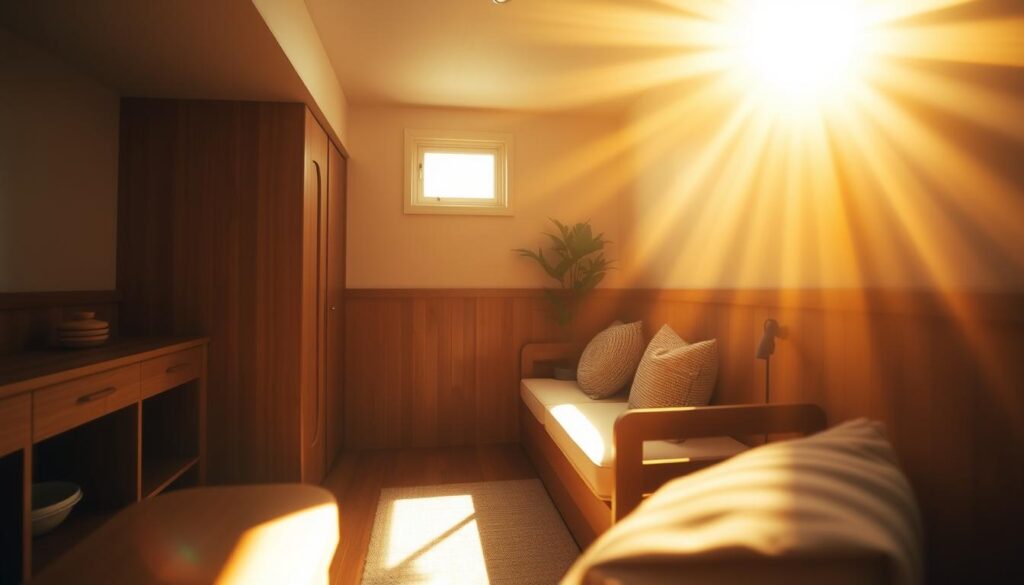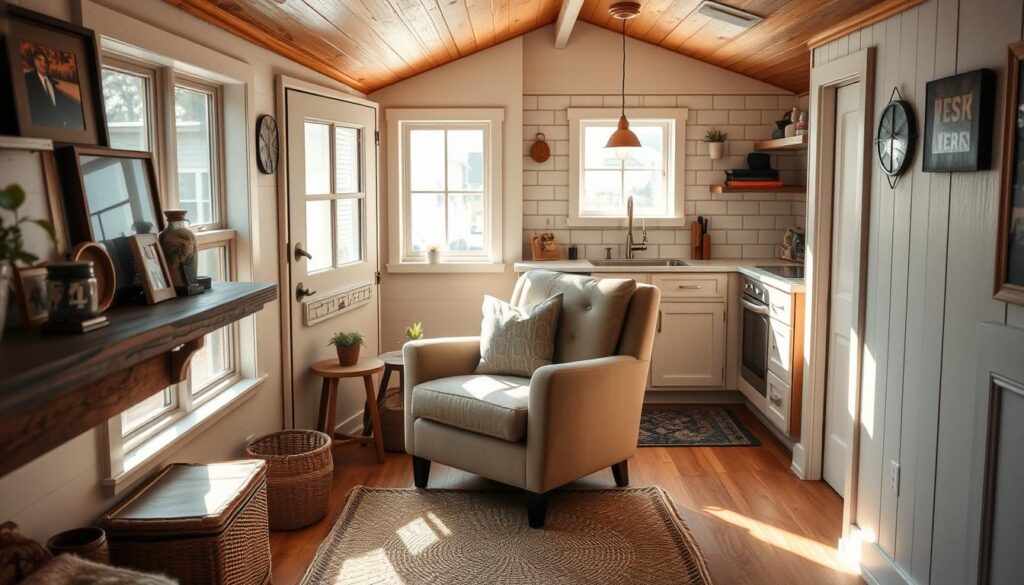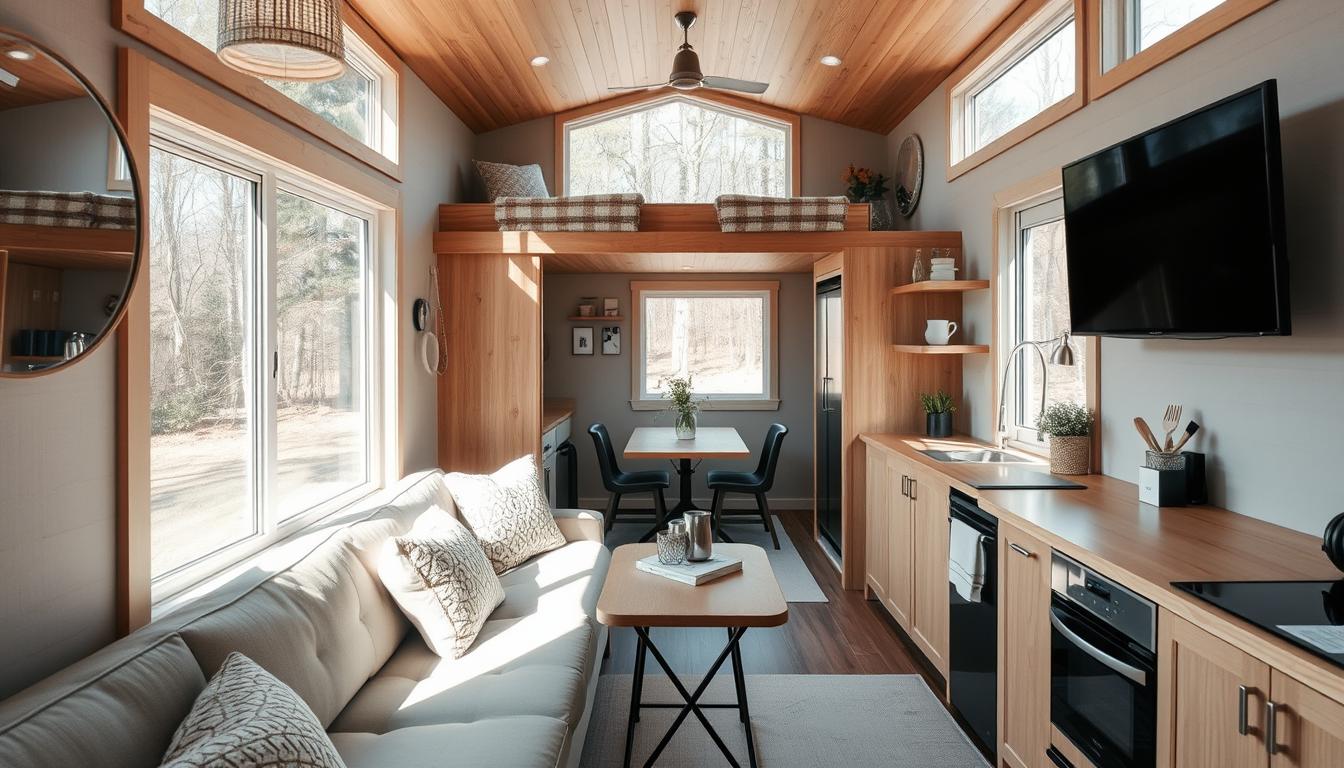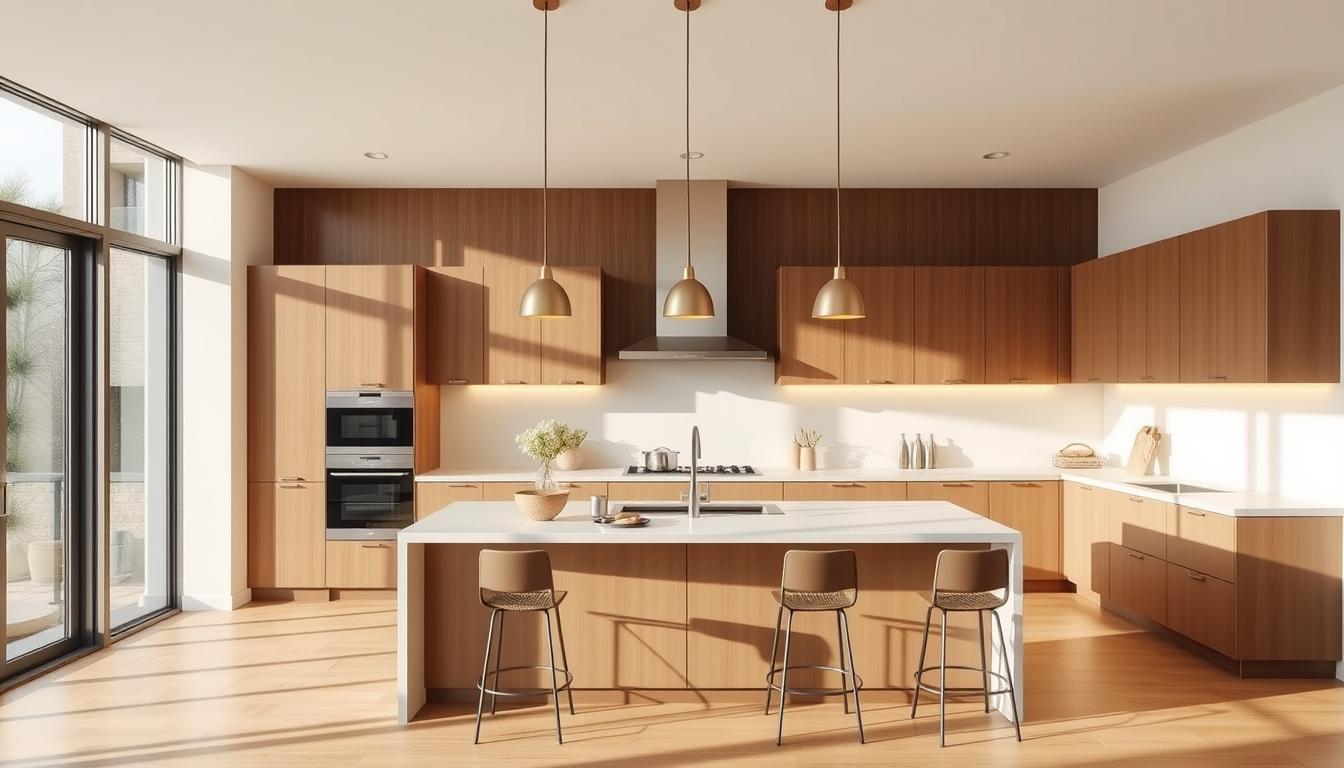The tiny home movement is growing fast, with over 10,000 tiny homes in the United States. As more people join, the need for small space decorating that’s both efficient and stylish grows too.
We’ll look at the best tiny home interior ideas to make the most of your space. By using furniture that does more than one thing and smart storage, tiny homes can become cozy and functional. This turns small spaces into places of comfort and relaxation.
Key Takeaways
- Efficient design is crucial for maximizing space in small homes.
- Multi-functional furniture can greatly enhance livability.
- Smart storage solutions are essential for maintaining a clutter-free environment.
- Stylish decorating can make small spaces feel more spacious.
- Careful planning is necessary to create a comfortable tiny home.
The Importance of Space Optimization in Tiny Homes
Effective space optimization is key to a functional tiny home. In the world of compact living, small spaces come with big challenges. But, with the right design, tiny homes can be both efficient and comfortable.
Understanding the Challenges of Small Spaces
Living in a tiny home has its hurdles, like limited storage and cramped areas. Gustaf Westman’s 322-square-foot studio apartment shows how design can solve these problems. He used space-saving solutions and minimalist design to make a cozy and useful space.
Common small space challenges include:
- Limited storage capacity
- Cramped living areas
- Need for multi-functional spaces
- Difficulty in maintaining a clutter-free environment
Benefits of Effective Space Design
Good space design can greatly improve life in tiny homes. It leads to a more organized and clutter-free home. For more tips on designing tiny home interiors, check out our guide on designing tiny home interiors.
The advantages of effective space design are:
| Benefit | Description |
|---|---|
| Increased Efficiency | Well-designed spaces can improve the functionality of tiny homes. |
| Enhanced Comfort | By maximizing space, homeowners can enjoy a more comfortable living environment. |
| Reduced Clutter | Effective space design helps maintain a clutter-free environment. |
Understanding space optimization’s challenges and benefits helps us create tiny homes that are functional and welcoming. As we dive deeper into tiny home design, it’s clear that optimizing space is essential for making the most of these compact living spaces.
Smart Storage Solutions for Tiny Homes
Effective storage is key in tiny home decor. It helps keep the living space organized. In tiny homes, every inch matters. Using smart storage solutions makes the space more livable.
Multi-Functional Furniture
Using multi-functional furniture is a great way to save space. For example, Crate & Barrel’s Grayson oak wood bed has built-in storage. It serves multiple purposes, saving space.
Ottomans with storage can be both seating and storage. Our guide to designing tiny homes offers more tips on choosing the right furniture.
Vertical Storage Ideas
Using vertical space is essential in tiny homes. Installing shelves or storage units up to the ceiling boosts storage without taking up floor space. Wall-mounted shelves can hold books, decorations, and kitchenware.
This keeps the floor clear and makes the room look bigger.
Hidden Storage Tricks
Hidden storage keeps tiny homes clutter-free. Solutions like pull-out drawers under stairs or storage under beds hide items. This keeps the living area tidy.
Furniture with hidden storage, like coffee tables with lift tops, also helps. These solutions make the space more organized.
By using these space-saving solutions, tiny homes become more organized and comfortable. Whether it’s multi-functional furniture, vertical storage, or hidden storage, there are many ways to improve storage. This makes tiny homes more livable and cozy.
Cozy Living Areas in Tiny Homes
Turning a tiny home into a cozy space is all about smart design and special touches. We can use our small area to make a warm and welcoming place.
Creating an Inviting Atmosphere
To make our tiny home inviting, we need comfortable seating and soft lighting. Plush sofas or big pillows can add comfort. Soft lights come from table lamps or string lights.
For example, a cozy reading nook can make our tiny home feel bigger and more relaxing. We can do this by putting a comfy chair in a quiet spot and adding a floor lamp for a warm light.
Choosing the Right Color Palette
The colors we pick really change how our tiny home feels. Light colors on walls and floors make it seem bigger. Warm colors add coziness.
Here are some popular color schemes for tiny homes:
| Color Palette | Description | Effect on Space |
|---|---|---|
| Monochromatic Neutrals | Using different shades of a single neutral color. | Makes the space feel larger and more cohesive. |
| Soft Pastels | Incorporating soft pastel shades for a calming effect. | Adds a touch of warmth without overwhelming the space. |
| Earth Tones | Using shades reminiscent of the earth, such as greens and browns. | Creates a cozy and natural atmosphere. |
By picking the right colors and adding cozy touches, we can make our tiny home’s living area feel both roomy and welcoming.
Designing a Functional Kitchen
Renovating a tiny home’s kitchen is key. It’s not just for cooking. It’s about making a space that’s efficient, comfy, and fun.
We must think about layout, appliances, and storage. Let’s explore ways to make tiny home kitchens work well.
Compact Appliances and Gadgets
Finding the right appliances is tough in tiny kitchens. Choose compact ones made for small spaces. They save room and use less energy.
Look for mini fridges, induction cooktops, and microwaves. Also, pick gadgets that do many things. This cuts down on clutter and boosts efficiency.
Open Shelving vs. Cabinets
Should you use open shelving or cabinets in tiny kitchens? Open shelving makes spaces feel bigger and items easy to grab. But, it can get messy if not kept tidy.
Cabinets offer lots of storage and keep things neat. The best mix is a bit of both. Use open shelving for things you use a lot and cabinets for the rest.
Here’s a table to show the difference between open shelving and cabinets:
| Feature | Open Shelving | Cabinets |
|---|---|---|
| Accessibility | Easy access to items | Items are stored away |
| Storage Capacity | Limited storage | Ample storage |
| Aesthetic Appeal | Can make space feel larger | Can be customized to fit design |
By thinking about these points and using smart solutions, we can make tiny kitchens both useful and lovely.
Transforming Your Bathroom
The bathroom in a tiny home is a design challenge. We can overcome it with clever ideas. We must think creatively to save space while keeping it functional and stylish.
When designing a tiny home bathroom, choosing space-saving fixtures is key. A wall-mounted sink or a pedestal sink is a good choice. They use less floor space than traditional vanities.
Space-Saving Fixtures
Some great space-saving fixtures for tiny home bathrooms include:
- Compact toilets with built-in storage
- Shower stalls with corner sinks
- Wall-mounted toilets and bidets
These fixtures save space and make the bathroom layout more efficient and streamlined.
Stylish Yet Functional Elements
Adding stylish yet functional elements can make the bathroom look better. Use light colors on walls and floors. This makes the space feel open and bright.
Here’s a look at different materials for bathroom fixtures and their benefits:
| Material | Durability | Maintenance | Aesthetic Appeal |
|---|---|---|---|
| Stainless Steel | High | Easy | Modern |
| Copper | High | Moderate | Warm, Luxurious |
| Acrylic | Medium | Easy | Versatile |
By using these space-saving and stylish elements, we can make a tiny home bathroom that’s both useful and beautiful. It shows our personal style and preferences.
Utilizing Natural Light in Tiny Spaces
Maximizing natural light is key to making tiny homes feel bigger and more welcoming. By using natural light wisely, we can make our living areas feel more open and inviting.

One effective way to do this is by placing windows carefully. By putting windows where they catch the sun’s path, we can light up our homes all day long.
Window Placement Strategies
Choosing the right spot for windows is important. For example, south-facing windows get the most sunlight, perfect for living rooms. On the other hand, north-facing windows offer softer, indirect light, great for bedrooms or home offices.
- South-facing windows for maximum sunlight
- North-facing windows for softer, indirect light
- East and west-facing windows for morning and afternoon sunlight
By planning where to put windows, we can use less artificial light. This makes our homes energy-efficient and more welcoming.
Light-Reflective Surfaces
Using light-reflective surfaces also boosts natural light in tiny homes. Mirrors, glossy finishes, and light-colored paints can make a room brighter.
For instance, a mirror opposite a window can bounce natural light into the room. This makes the room feel bigger and brighter. Light-colored walls and ceilings also help spread natural light evenly.
By using these tips, we can make our tiny homes brighter, more inviting. They’ll feel more spacious than they actually are.
Outdoor Extensions for Tiny Homes
Tiny homes have limited indoor space, but we can make our outdoor areas inviting. This way, we expand our living space and connect with nature. It also boosts our well-being.
Creating an Inviting Outdoor Space
To make an outdoor space welcoming, think about layout and function. Outdoor furniture that’s compact and does more than one thing works well. For instance, a storage ottoman can be a seat and a place to store things.
Utilizing Balconies and Patios
Balconies and patios are great for tiny homes, offering extra space for relaxation and fun. Use space-saving furniture like foldable tables and chairs to make the most of it. Adding outdoor decor like lanterns and planters can also improve the feel of the space.
Other ideas include setting up a cozy reading nook or an outdoor dining area. With careful planning, we can greatly improve our tiny home living.
Personal Touches: Making It Yours
We think adding personal decor is crucial to making your tiny house feel like home. Unique touches can turn your small space into a cozy, inviting place that shows off your personality.
Incorporating Personal Decor
Personal decor makes your tiny home truly yours. Think about adding family photos, heirlooms, or artwork that means something to you. These items add interest and warmth, giving your home character.
Displaying personal items can be creative. Use wall-mounted shelves, decorative baskets, or vintage containers. This keeps things organized and makes your home look great.

DIY Projects for Personality
Doing DIY projects is a great way to add personality to your tiny home. You can make your own furniture or decor. Think about using old items or upcycling materials to create something unique.
Some DIY ideas include:
- Creating a gallery wall with personal photos and artwork
- Making your own throw pillows and blankets
- Upcycling old furniture into functional pieces
Adding these personal touches makes your tiny home special and truly yours.
By mixing personal decor and DIY projects, you can make a space that’s both functional and reflects your style. We encourage you to try different ideas and have fun making your tiny house a home.
Sustainable Tiny Home Design Ideas
Exploring tiny home design means thinking about the environment. We can lessen our carbon footprint by choosing sustainable options. For example, using natural materials like wood adds warmth and brings nature inside.
Eco-Friendly Materials
Choosing eco-friendly materials is key to sustainable design. Reclaimed materials are great because they reduce waste and add character. Websites like Sustainability Success offer ideas on using these materials.
Energy-Efficient Solutions
Energy-efficient solutions are crucial for tiny homes. Solar panels, green roofs, and smart gadgets like voice-activated lights help save energy. These features make our homes more sustainable and eco-friendly.



